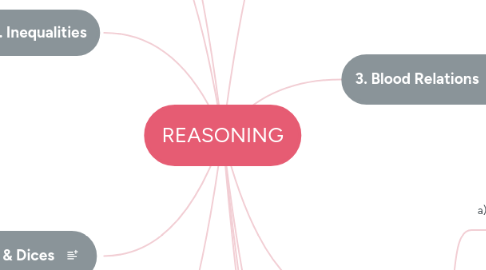REASONING
Door Richa Singh


1. 2. Direction Sense
1.1. a) dawn & dusk b) sunrise & sunset c) right & left d) north, south, east, west
2. 4. Seating Arrangement
2.1. a) Bounded bodies
2.2. b) Linear bodies
3. 6. Inequalities
3.1. a) Syllogism
3.1.1. i) Universal
3.1.1.1. • Affirmative (type A)
3.1.1.2. • Negative (type E)
3.1.2. ii) Partial
3.1.2.1. • Affirmative (type I)
3.1.2.2. • Negative (type O)
3.2. b) Inequality
3.2.1. > greater than < less than = equal to ≥ greater than or equal to ≤ less than or equal to
4. 8. Cubes & Dices
4.1. • sum of opposite sides = 7 • adjacent sides can never be zero (4 die) • taking common, cw/acw (2 die– to find opposites) • Painted Die 3 sides = number of corners 2 sides = (n-2)×12 1 side = (n-2)² ×6 0 side = (n-2)³ • when 2 faces are common= uncommon faces are opposite • folding into a box top left–front–right bottom back
5. 10. Input-Output
5.1. a) Word based
5.2. b) Number based
5.3. c) Mixed
5.4. d) Box based
6. 1. Coding Decoding
6.1. a) Position Shifting AT = BU (+1)
6.1.1. • alphabet series
6.1.2. • number series
6.1.3. • alpha-numeric
6.1.4. • alpha-symbolic
6.2. b) Positioning A=1 B=2 AB= 1+2= 3 or 26+25= 51
6.3. c) Opposite AZ BY CX
6.4. d) Given Coding If PST= NUM STP= ? (STP= UMN)
6.5. e) common words in different codes
7. 3. Blood Relations
7.1. • + represents female and - represents male • <—> is for married couples • — is used for siblings • generations are spread out row-wise {...4th 3rd 2nd 1st }
8. 5. Series
8.1. a) Number
8.1.1. • Consecutive odd/even numbers. • Consecutive prime/composite numbers. • Squares/cubes of some numbers with/ without variation of addition or substraction of some number • Sum/product/difference of preceding number (s) • Addition/subtraction/multiplication/division by a number
